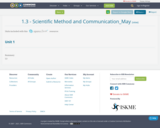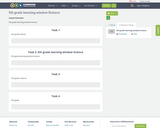
Draft of 1.1
- Subject:
- Applied Science
- Material Type:
- Activity/Lab
- Date Added:
- 05/31/2018

Draft of 1.1

sci

1.2

Science

1.3

This video adapted from the Valdez Museum & Historical Archive, explores what happened during the Great Alaska Earthquake of 1964 through original footage, first-person accounts, and animations illustrating plate tectonics.

In this Wonder of the DayR, we learn about why flamingos are pink. Students have the opportunity to explore the Wonder either as a class or individually. With suggestions for different age groups, Wonder #1 has an activity to engage students with drawing, writing description, or both.

, We will learn about why flamingos are pink. Students have the opportunity to explore as a class or individually. With suggestions for different age groups. This resource has some activities to engage students with drawing, writing descriptions, or both.

In this Wonder of the DayR, we learn about why flamingos are pink. Students have the opportunity to explore the Wonder either as a class or individually. With suggestions for different age groups, Wonder #1 has an activity to engage students with drawing, writing description, or both.

1st grade science key vocabulary English/Spanish translations (space to add drawing as well).

This resource was created by Judy Prewett, in collaboration with Dawn DeTurk, Hannah Blomstedt, and Julie Albrecht, as part of ESU2's Integrating the Arts project. This project is a four year initiative focused on integrating arts into the core curriculum through teacher education, practice, and coaching.


Students may recognize the importance of their senses, but they don't often focus on them individually. Students will experiment with sounds made by leaves, feeling different textures, observing different colors, and much more.

In this unit students will build and construct an understanding of how matter and organisms interact creating change in our biosphere and in turn affect all types of ecosystems. Then using these skills and content they will be able to communicate, model and create solutions to phenomena, environmental emergencies or concerns. environmental concerns or endangered organisms.

5th grade learning window Science

6th Grade Regular Science Scope & Sequence

Unit Summary
This unit on metabolic reactions in the human body starts out with students exploring a real case study of a middle-school girl named M’Kenna, who reported some alarming symptoms to her doctor. Her symptoms included an inability to concentrate, headaches, stomach issues when she eats, and a lack of energy for everyday activities and sports that she used to play regularly. She also reported noticeable weight loss over the past few months, in spite of consuming what appeared to be a healthy diet. Her case sparks questions and ideas for investigations around trying to figure out which pathways and processes in M’Kenna’s body might be functioning differently than a healthy system and why.
Students investigate data specific to M’Kenna’s case in the form of doctor’s notes, endoscopy images and reports, growth charts, and micrographs. They also draw from their results from laboratory experiments on the chemical changes involving the processing of food and from digital interactives to explore how food is transported, transformed, stored, and used across different body systems in all people. Through this work of figuring out what is causing M’Kenna’s symptoms, the class discovers what happens to the food we eat after it enters our bodies and how M’Kenna’s different symptoms are connected.
This unit builds towards the following NGSS Performance Expectations (PEs) as described in the OpenSciEd Scope & Sequence: MS-LS1-3, MS-LS1-5, MS-LS1-7, MS-PS1-1, MS-PS1-2. The OpenSciEd units are designed for hands-on learning, and therefore materials are necessary to teach the unit. These materials can be purchased as science kits or assembled using the kit material list.
Additional Unit InformationNext Generation Science Standards Addressed in this UnitPerformance ExpectationsThis unit builds toward the following NGSS Performance Expectations (PEs):

7th Grade Regular Science Scope & Sequence

Unit Summary
In this unit, students develop ideas related to how sounds are produced, how they travel through media, and how they affect objects at a distance. Their investigations are motivated by trying to account for a perplexing anchoring phenomenon — a truck is playing loud music in a parking lot and the windows of a building across the parking lot visibly shake in response to the music.
They make observations of sound sources to revisit the K–5 idea that objects vibrate when they make sounds. They figure out that patterns of differences in those vibrations are tied to differences in characteristics of the sounds being made. They gather data on how objects vibrate when making different sounds to characterize how a vibrating object’s motion is tied to the loudness and pitch of the sounds they make. Students also conduct experiments to support the idea that sound needs matter to travel through, and they will use models and simulations to explain how sound travels through matter at the particle level.
This unit builds toward the following NGSS Performance Expectations (PEs) as described in the OpenSciEd Scope & Sequence: MS-PS4-1, MS-PS4-2. The OpenSciEd units are designed for hands-on learning and therefore materials are necessary to teach the unit. These materials can be purchased as science kits or assembled using the kit material list.

8th Grade Regular Science Scope & Sequence